最新完整版专四英语语法考点分析解析
专四语法 可可英语

专四语法可可英语好的,以下是一篇有关可可英语专四语法的文章:可可英语专四语法精讲一、虚拟语气虚拟语气是英语语法中一个非常重要的部分,在专四考试中也是必考的知识点。
虚拟语气用来表示与实际情况相反的情况或者表达主观上的愿望、建议、猜测等。
虚拟语气的用法包括与现在事实相反、与过去事实相反和与将来事实相反三种情况。
1. 与现在事实相反:使用动词的过去式(be动词用were),从句使用would+动词原形。
例如:If I were you,I would choose to study abroad.(如果我是你,我会选择出国留学。
)2. 与过去事实相反:使用“would+have+过去分词”,从句使用“had+过去分词”。
例如:If we had known the answer,we would have told you.(如果我们知道答案,我们早就告诉你了。
)3. 与将来事实相反:使用“would+动词原形”,从句使用“were+to+动词原形”或者“should+动词原形”。
例如:If it were to rain tomorrow,the football match would be postponed.(如果明天下雨,足球比赛就会被推迟。
)二、定语从句定语从句是英语语法中的另一个重要知识点,也是专四考试的重点。
定语从句用来修饰名词,通常放在所修饰名词之后。
引导定语从句的关联词包括that、which、who、whose等。
1. 使用that的情况:当先行词为all、something、nothing、this等不定代词时,或者先行词被形容词最高级修饰时,多用that引导定语从句。
例如:This is the most interesting book that I have ever read.(这是我读过的最有趣的书。
)2. 使用which的情况:当引导词前面有逗号或放在句末时,通常使用which。
英语专业四级考试语法精讲[1]
![英语专业四级考试语法精讲[1]](https://img.taocdn.com/s3/m/a66f1368561252d380eb6e8d.png)
英语专业四级考试—语法精讲虚拟语气第一部分:概述虚拟语气类型(宾语从句;状语从句;名词性从句(主语从句,同位语从句,表语从句);定语从句;特殊类型(感叹句);省略if 的虚拟法(倒装))ExamplesThe rapid change of society requires that college students adapt to the world outside campus by getting to know the society.I would rather that you did nothing for the time being.I wish that I were a student again.I wished that I had followed his suggestion.名词性从句中的虚拟主语从句(it is +adj./p.p that)同位语从句(The +n. that )表语从句(n. +be that)省略if 的虚拟法(倒装)(1)虚拟语气中如果从句引导词if / whether 省略,从句中需要倒装,提前助动词(系动词)或情态动词。
Eg. If it should rain tomorrow, we would not be able to have the sports meeting.=Should it rain tomorrow, we should not be able to have the sports meeting.省略if 的虚拟法(倒装)(2)Eg. Whether it (may) be fine or rainy, we would have the sports meeting. =Be it fine or rainy, we would have the sports meeting.If she had been given more information, she could have answered the questions.=Had she been given more information, she could have answered the questions.第二部分详解&总结虚拟语气的动词标志―insist, suggest, require, request, demand, propose, prefer, maintain, move,urge, recommend, command, order‖等动词表“建议、愿望”时,其后宾语从句中谓语动词要用虚拟语气。
高校英语专业四级考试_词汇语法详细解答
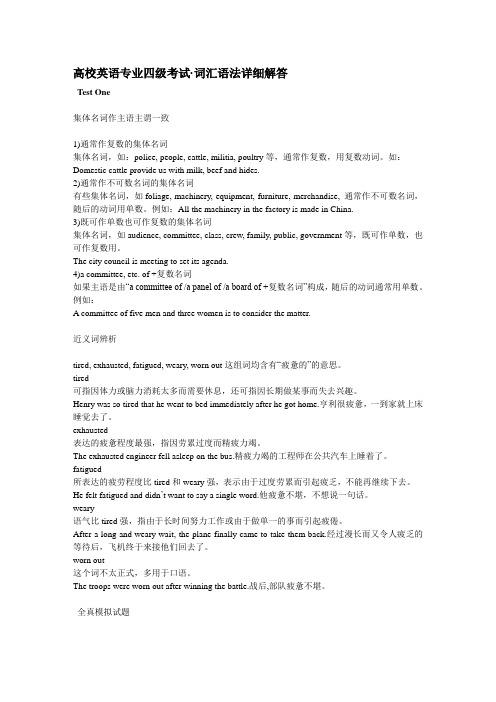
高校英语专业四级考试·词汇语法详细解答Test One集体名词作主语主谓一致1)通常作复数的集体名词集体名词,如:police, people, cattle, militia, poultry等,通常作复数,用复数动词。
如: Domestic cattle provide us with milk, beef and hides.2)通常作不可数名词的集体名词有些集体名词,如foliage, machinery, equipment, furniture, merchandise, 通常作不可数名词,随后的动词用单数。
例如:All the machinery in the factory is made in China.3)既可作单数也可作复数的集体名词集体名词,如audience, committee, class, crew, family, public, government等,既可作单数,也可作复数用。
The city council is meeting to set its agenda.4)a committee, etc. of +复数名词如果主语是由“a committee of /a panel of /a board of +复数名词”构成,随后的动词通常用单数。
例如:A committee of five men and three women is to consider the matter.近义词辨析tired, exhausted, fatigued, weary, worn out这组词均含有“疲惫的”的意思。
tired可指因体力或脑力消耗太多而需要休息,还可指因长期做某事而失去兴趣。
Henry was so tired that he went to bed immediately after he got home.亨利很疲惫,一到家就上床睡觉去了。
英语专四语法考点总结
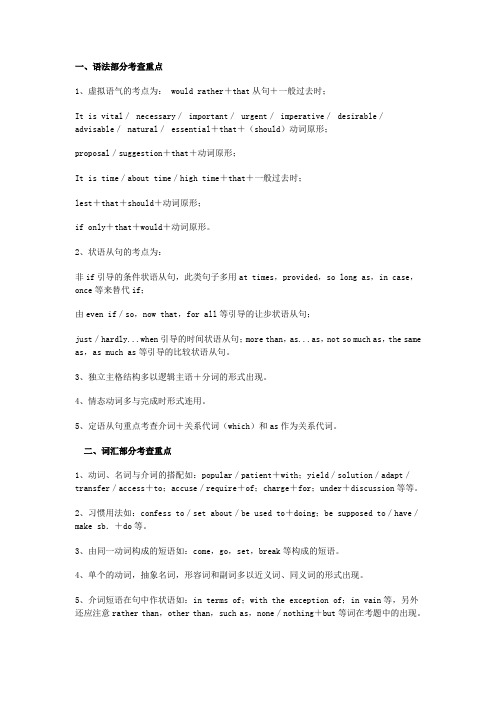
一、语法部分考查重点1、虚拟语气的考点为: would rather+that从句+一般过去时;It is vital/ necessary/ important/ urgent/ imperative/ desirable/advisable/ natural/ essential+that+(should)动词原形;proposal/suggestion+that+动词原形;It is time/about time/high time+that+一般过去时;lest+that+should+动词原形;if only+that+would+动词原形。
2、状语从句的考点为:非if引导的条件状语从句,此类句子多用at times,provided,so long as,in case,once等来替代if;由even if/so,now that,for all等引导的让步状语从句;just/hardly...when引导的时间状语从句;more than,as...as,not so much as,the same as,as much as等引导的比较状语从句。
3、独立主格结构多以逻辑主语+分词的形式出现。
4、情态动词多与完成时形式连用。
5、定语从句重点考查介词+关系代词(which)和as作为关系代词。
二、词汇部分考查重点1、动词、名词与介词的搭配如:popular/patient+with;yield/solution/adapt/transfer/access+to;accuse/require+of;charge+for;under+discussion等等。
2、习惯用法如:confess to/set about/be used to+doing;be supposed to/have/make sb.+do等。
3、由同一动词构成的短语如:come,go,set,break等构成的短语。
CET4语法考点全解析

CET4语法考点全解析在准备英语四级考试的过程中,语法一直是考生们比较头疼的一个部分。
由于语法知识点众多,考试时往往容易混淆,因此,了解并掌握每个语法考点是非常重要的。
本文将对CET4考试中常见的语法考点进行全面解析,帮助考生在备考中有针对性地进行复习。
一、冠词冠词是英语中一种常见的虚词,包括定冠词“the”和不定冠词“a/an”。
定冠词“the”表示特指,常用于特定的人、事物或概念;不定冠词“a/an”表示泛指,常用于不特定的人、事物或概念。
在考试中,考生需要注意正确使用冠词,避免使用错误或遗漏。
二、时态英语时态是考试中的重要考点之一,主要包括一般现在时、一般过去时、一般将来时、现在进行时、过去进行时、过去将来时等。
考生需要根据句意和语境选择正确的时态,避免时态错误导致句子不通顺或不符合语法规则。
三、名词名词是英语中一种表示事物、人或概念的词汇,可分为可数名词和不可数名词。
在考试中,考生需要注意名词的单复数形式、所有格形式以及名词性从句的使用,避免在句子中出现名词错误。
四、动词动词是英语中一种表示行为或状态的词汇,主要包括一般动词、情态动词、动词的时态和语态等。
在考试中,考生需要注意动词的时态和语态的正确使用,避免主谓不一致或动词形式错误。
五、代词代词是英语中一种用来代替名词或其他词汇的词汇,包括人称代词、物主代词、反身代词等。
在考试中,考生需要注意代词的正确使用,避免在句子中出现代词错误或误解。
六、连接词连接词是英语中一种用来连接句子、短语或词汇的词汇,包括并列连词、从属连词和连接副词等。
在考试中,考生需要注意连接词的使用,保持句子逻辑性和通顺性。
七、介词介词是英语中一种用来表示位置、方向或关系的词汇,包括时间介词、地点介词和方式介词等。
在考试中,考生需要注意介词的正确使用,避免在句子中出现介词错误或误解。
总结:通过上述对CET4语法考点的全面解析,考生可以更好地理解和掌握英语语法知识,提高语法水平和应试能力。
专四语法全析
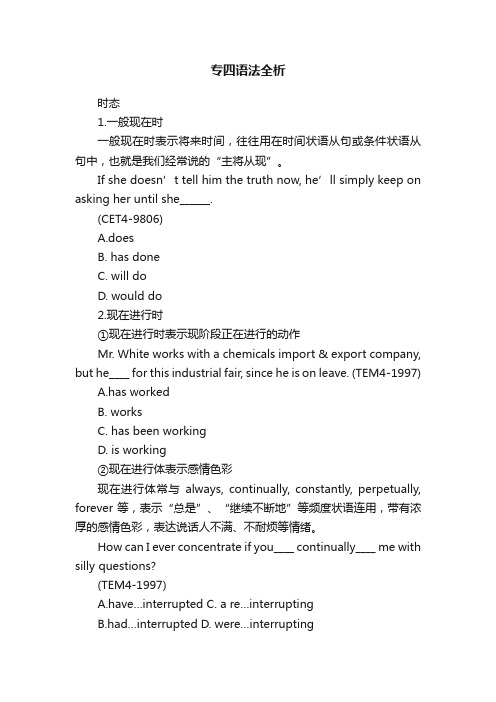
专四语法全析时态1.一般现在时一般现在时表示将来时间,往往用在时间状语从句或条件状语从句中,也就是我们经常说的“主将从现”。
If she doesn’t tell him the truth now, he’ll simply keep on asking her until she______.(CET4-9806)A.doesB. has doneC. will doD. would do2.现在进行时①现在进行时表示现阶段正在进行的动作Mr. White works with a chemicals import & export company, but he____ for this industrial fair, since he is on leave. (TEM4-1997)A.has workedB. worksC. has been workingD. is working②现在进行体表示感情色彩现在进行体常与always, continually, constantly, perpetually, forever等,表示“总是”、“继续不断地”等频度状语连用,带有浓厚的感情色彩,表达说话人不满、不耐烦等情绪。
How can I ever concentrate if you____ continually____ me with silly questions?(TEM4-1997)A.have…interrupted C. a re…interruptingB.had…interrupted D. were…interrupting③ be+being + 形容词状态动词be的进行时态(be being)后面接行为形容词brave, careful, stupid, clever, foolish, polite, kind和shy等,表示主语所表现的非一贯性特点或故意的行为或暂时出现的平时所没有的某种特质。
(完整版)专四语法专题复习:限定词解读

➢限定词与三类名词的搭配关系
➢限定词与限定词的搭配关系 ➢若干限定词用法比较
(1)能与三类名词搭配的限定词
有些限定词如the,some,any,no,other,whose以及my, your等物主限定词和名词属格(John’s,my friend’s)等能与三类 名词搭配。例如:
the book
either, neither, enough); • 5、疑问限定词和关系限定词: what (ever),
which (ever),whose
b) 前位限定词包括 all,both,half; double,twice,three times等; one-third,two-fifths等; what,such (a/ an) (跨类限定词)。
A. the other B. enough C. a little D. much
4. There’s _C_ water in the bottle.
A. few B. a number of C. plenty of D. any
5. There is _C_ iron in this mine than in that one.
7. He has published _B_ short stories in English.
A. a great amount of B. a number of C. another D. many a
8. We had _D_ rainfalls last summer.
A. too much B. little C. a little D. only several
both workers
(a) few words
专四语法(做完题总结)解读
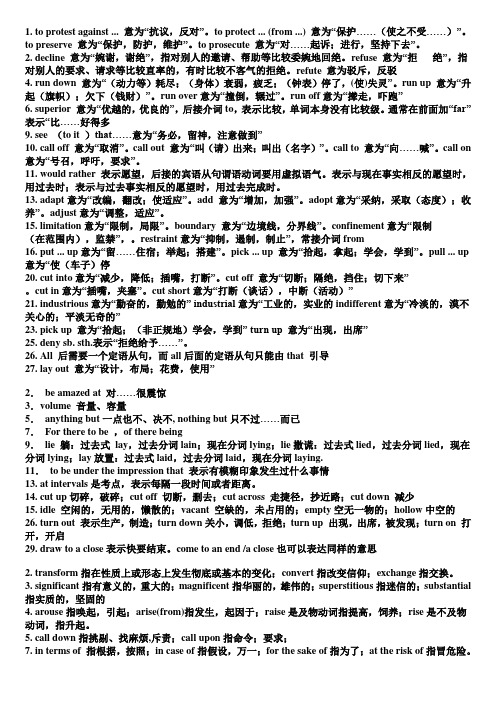
1. to protest against ... 意为“抗议,反对”。
to protect ... (from ...) 意为“保护……(使之不受……)”。
to preserve 意为“保护,防护,维护”。
to prosecute 意为“对……起诉;进行,坚持下去”。
2. decline 意为“婉谢,谢绝”,指对别人的邀请、帮助等比较委婉地回绝。
refuse 意为“拒绝”,指对别人的要求、请求等比较直率的,有时比较不客气的拒绝。
refute 意为驳斥,反驳4. run down 意为“(动力等)耗尽;(身体)衰弱,疲乏;(钟表)停了,(使)失灵”。
run up 意为“升起(旗帜);欠下(钱财)”。
run over意为“撞倒,辗过”。
run off意为“撵走,吓跑”6. superior 意为“优越的,优良的”,后接介词to,表示比较,单词本身没有比较级。
通常在前面加“far”表示“比……好得多9. see (to it )that……意为“务必,留神,注意做到”10. call off 意为“取消”。
call out 意为“叫(请)出来;叫出(名字)”。
call to 意为“向……喊”。
call on 意为“号召,呼吁,要求”。
11. would rather 表示愿望,后接的宾语从句谓语动词要用虚拟语气。
表示与现在事实相反的愿望时,用过去时;表示与过去事实相反的愿望时,用过去完成时。
13. adapt意为“改编,翻改;使适应”。
add 意为“增加,加强”。
adopt意为“采纳,采取(态度);收养”。
adjust意为“调整,适应”。
15. limitation意为“限制,局限”。
boundary 意为“边境线,分界线”。
confinement意为“限制(在范围内),监禁”,。
restraint意为“抑制,遏制,制止”,常接介词from16. put ... up意为“留……住宿;举起;搭建”。
英语专四专八语法规则辨析整理总结全

英语专四专八语法规则辨析整理总结全
英语专四专八是一项考试,语法是考试的重点之一。
以下是对英语语法中一些常见的规则进行梳理和辨析总结,以便备考时准确掌握。
时态
英语中有多种时态,包括现在时、过去时、将来时等。
时态在语法中很重要,因为它可以表达行动的时间和状态。
一般来说,英语语法中最基本的时态是现在时、过去时和将来时。
主谓一致
主谓一致是英语语法中的重点之一,指的是主语和谓语必须在人称和数上保持一致。
例如,单数主语需要用单数谓语动词,而复数主语需要用复数谓语动词。
冠词
英语语法中有三种冠词:a、an和the。
a和an是不定冠词,表示单数可数名词,而the是定冠词,表示特定的人、物、地点等。
名词
英语语法中有三种名词:可数名词、不可数名词和集合名词。
可数名词可以与数词连用表示数量,不可数名词不能与数词连用,集合名词表示由众多相似个体组成的群体。
动词
动词是英语语法中最重要的部分之一。
动词有时态、语态和语气等方面的变化,动词的不同形式反映了不同的语法含义。
形容词和副词
英语语法中的形容词和副词是修饰词,用于描述名词和动词。
形容词一般在名词前面使用,副词则用于修饰动词、形容词和其他副词。
介词
英语语法中的介词用于表示时间、空间和关系等。
介词通常出现在名词或代词之前,用于指示它们与其他单词之间的关系。
以上是英语专四专八语法的规则辨析整理总结,希望对备考的同学有所帮助。
最新完整版专四英语语法考点分析解析
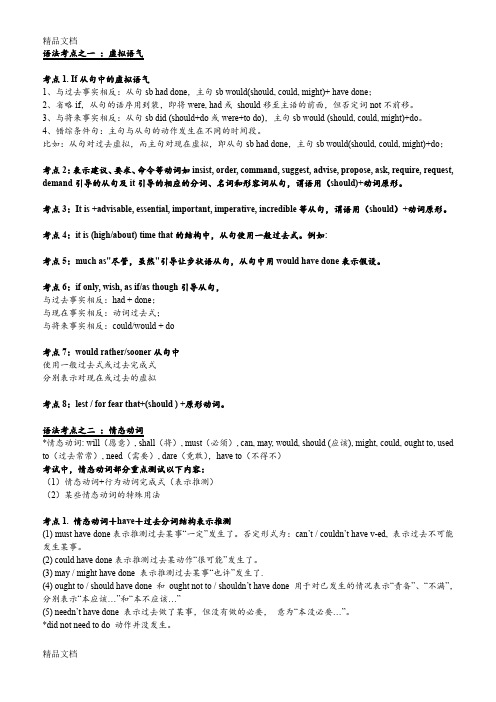
语法考点之一:虚拟语气考点1. If从句中的虚拟语气1、与过去事实相反:从句sb had done,主句sb would(should, could, might)+ have done;2、省略if,从句的语序用到装,即将were, had或should移至主语的前面,但否定词not不前移。
3、与将来事实相反:从句sb did (should+do或were+to do),主句sb would (should, could, might)+do。
4、错综条件句:主句与从句的动作发生在不同的时间段。
比如:从句对过去虚拟,而主句对现在虚拟,即从句sb had done,主句sb would(should, could, might)+do;考点2:表示建议、要求、命令等动词如insist, order, command, suggest, advise, propose, ask, require, request, demand引导的从句及it引导的相应的分词、名词和形容词从句,谓语用(should)+动词原形。
考点3:It is +advisable, essential, important, imperative, incredible等从句,谓语用(should)+动词原形。
考点4:it is (high/about) time that的结构中,从句使用一般过去式。
例如:考点5:much as"尽管,虽然"引导让步状语从句,从句中用would have done表示假设。
考点6:if only, wish, as if/as though引导从句,与过去事实相反:had + done;与现在事实相反:动词过去式;与将来事实相反:could/would + do考点7:would rather/sooner从句中使用一般过去式或过去完成式分别表示对现在或过去的虚拟考点8:lest / for fear that+(should ) +原形动词。
英语专业四级语法难点攻略

英语专业四级语法难点攻略语法是英语学习的基础,对于英语专业四级考试而言,掌握语法难点是非常重要的。
本文将针对英语专业四级语法难点进行详细的分析和攻略,帮助考生能够更好地应对考试。
一、主谓一致主谓一致是英语语法中的基本规则之一。
它指的是主语与谓语在人称和数上要保持一致。
然而,在实际运用中,考生常常会犯以下错误:1.复数主语+单数谓语:例如:The group of students is going on a trip. 正确应该是"The group of students are going on a trip."2.集体名词作主语时,既可以用单数谓语也可以用复数谓语:例如:The audience was/were excited. 但需要注意的是,如果强调集体中的个体,应使用复数谓语。
攻略:练习时要注意动词与主语的一致,特别是当主语为复数形式但含义为单数时。
要对常见的集体名词的用法有所了解,尤其是与个体强调语法特点。
二、动词时态动词时态在英语语法中占据重要位置,它用来表示一个动作或状态发生的时间。
在英语专业四级考试中,考生常常会遇到以下难点:1.过去完成时与过去完成进行时:过去完成时常用于过去的某个动作发生之后,再发生的动作之前。
而过去完成进行时则表示过去某一时间段正在进行的动作,常和表示有限制的时间状语连用。
2.情态动词应用:情态动词有一些特殊的用法,如情态动词can表示能力、may表示可能性等。
攻略:掌握各种时态的用法,尤其要注意它们的时间关系,多进行练习,增加熟练度。
针对情态动词,需要理解其不同的含义,学会根据不同的上下文进行正确选择。
三、非谓语动词非谓语动词是英语语法中一个重要的考点,它包括不定式、动名词和分词,攻克好这个难点非常关键:1.不定式的主动形式与被动形式:在句中使用不定式时,需要注意主动形式与被动形式的区别以及正确的搭配。
2.动名词和动词不定式的区别:动名词和动词不定式在形式和用法上有所差异,需要注意它们在句子中的作用和搭配。
专四真题语法分析
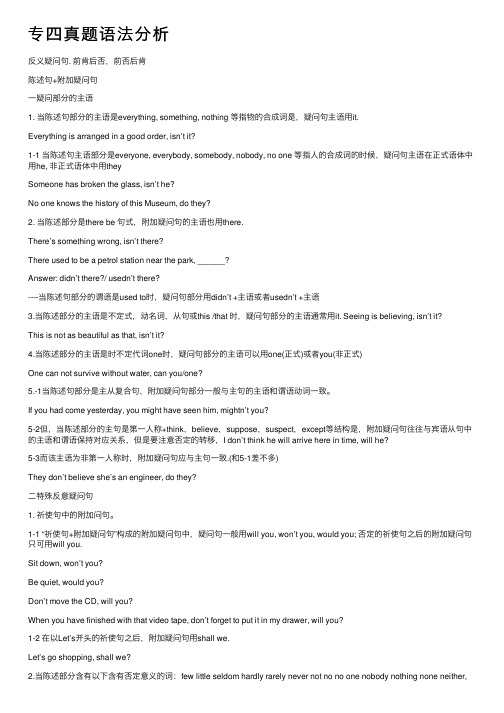
专四真题语法分析反义疑问句. 前肯后否,前否后肯陈述句+附加疑问句⼀疑问部分的主语1. 当陈述句部分的主语是everything, something, nothing 等指物的合成词是,疑问句主语⽤it.Everything is arranged in a good order, isn’t it?1-1 当陈述句主语部分是everyone, everybody, somebody, nobody, no one 等指⼈的合成词的时候,疑问句主语在正式语体中⽤he, ⾮正式语体中⽤theySomeone has broken the glass, isn’t he?No one knows the history of this Museum, do they?2. 当陈述部分是there be 句式,附加疑问句的主语也⽤there.There’s something wrong, isn’t there?There used to be a petrol station near the park, ______?Answer: didn’t there?/ usedn’t there?----当陈述句部分的谓语是used to时,疑问句部分⽤didn’t +主语或者usedn’t +主语3.当陈述部分的主语是不定式,动名词,从句或this /that 时,疑问句部分的主语通常⽤it. Seeing is believing, isn’t it?This is not as beautiful as that, isn’t it?4.当陈述部分的主语是时不定代词one时,疑问句部分的主语可以⽤one(正式)或者you(⾮正式)One can not survive without water, can you/one?5.-1当陈述句部分是主从复合句,附加疑问句部分⼀般与主句的主语和谓语动词⼀致。
(完整word版)英语专业四级考试语法汇总(word文档良心出品)

独立主格结构独立主格结构(Independent Genitive)有两部分组成,前一部份是名词或者代词,后一部分是非谓语动词(不定式、动名词和分词)或形容词、副词、或介词短语。
前后两部分具有逻辑主谓关系。
独立主格结构在句中做状语,多用于书面语。
独立主格结构本身不是句子,在句子中作状语,表示时间、原因、条件、伴随、目的等。
非谓语动词作状语,其逻辑主语须与主句主语保持一致。
若不一致,非谓语动词形式须另带主语,从而构成复合结构的形式作状语。
这种结构称为“独立结构”。
其中,非谓语动词主动用现在分词,被动用过去分词。
非谓语动词及其短语前面带有逻辑主语,逻辑主语的代词又是主格,故常称为“独立主格”。
“独立结构”在句中起状语作用,相当于状语从句,表示时间、原因、条件、方式或伴随等情况。
功能独立主格结构主要用于描绘性文字中,其作用相当于一个状语从句,常用来表示时间、原因、条件、行为方式或伴随情况等。
例如:表示时间The meeting being over, all of us went home. 开完会后我们都回家了。
Her work being done, she sat down for a cup of tea. 她干完了活,坐下来喝茶。
表示条件The condition being favorable, he may succeed. 若条件有利,他或许能成功。
表示原因There being no taxis, we had to walk. 没有出租车,我们只好步行。
He wrapped her up with great care, the night being dark and frosty. 夜又黑又冷,所以他把她裹得严严实实的。
表示伴随情况Almost all metals are good conductors, silver being the best of all. 几乎所有的金属都是良导体,而银则是最好的导体。
专四语法词汇试题答案与解析完整版
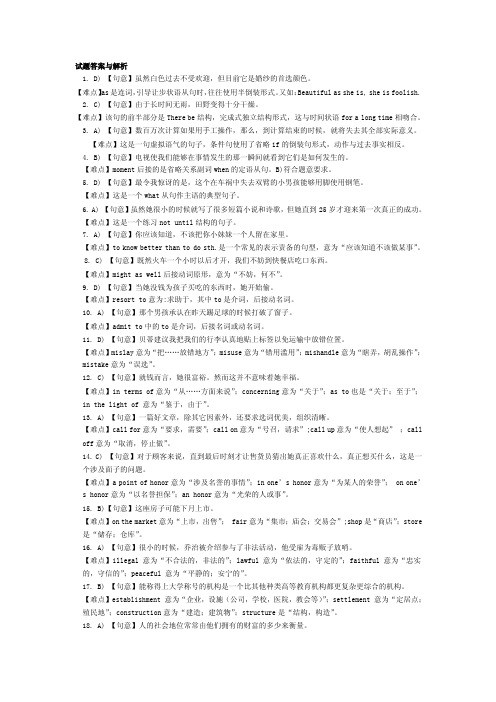
试题答案与解析1. D) 【句意】虽然白色过去不受欢迎,但目前它是婚纱的首选颜色。
【难点】as是连词,引导让步状语从句时,往往使用半倒装形式。
又如:Beautiful as she is, she is foolish.2. C) 【句意】由于长时间无雨,田野变得十分干燥。
【难点】该句的前半部分是There be结构,完成式独立结构形式,这与时间状语for a long time相吻合。
3. A) 【句意】数百万次计算如果用手工操作,那么,到计算结束的时候,就将失去其全部实际意义。
【难点】这是一句虚拟语气的句子,条件句使用了省略if的倒装句形式,动作与过去事实相反。
4. B) 【句意】电视使我们能够在事情发生的那一瞬间就看到它们是如何发生的。
【难点】moment后接的是省略关系副词when的定语从句。
B)符合题意要求。
5. D) 【句意】最令我惊讶的是,这个在车祸中失去双臂的小男孩能够用脚使用钢笔。
【难点】这是一个what从句作主语的典型句子。
6. A) 【句意】虽然她很小的时候就写了很多短篇小说和诗歌,但她直到25岁才迎来第一次真正的成功。
【难点】这是一个练习not until结构的句子。
7. A) 【句意】你应该知道,不该把你小妹妹一个人留在家里。
【难点】to know better than to do sth.是一个常见的表示责备的句型,意为“应该知道不该做某事”。
8. C) 【句意】既然火车一个小时以后才开,我们不妨到快餐店吃口东西。
【难点】might as well后接动词原形,意为“不妨,何不”。
9. D) 【句意】当她没钱为孩子买吃的东西时,她开始偷。
【难点】resort to意为:求助于,其中to是介词,后接动名词。
10. A) 【句意】那个男孩承认在昨天踢足球的时候打破了窗子。
【难点】admit to中的to是介词,后接名词或动名词。
11. D) 【句意】贝蒂建议我把我们的行李认真地贴上标签以免运输中放错位置。
英语专业四级语法专题讲解
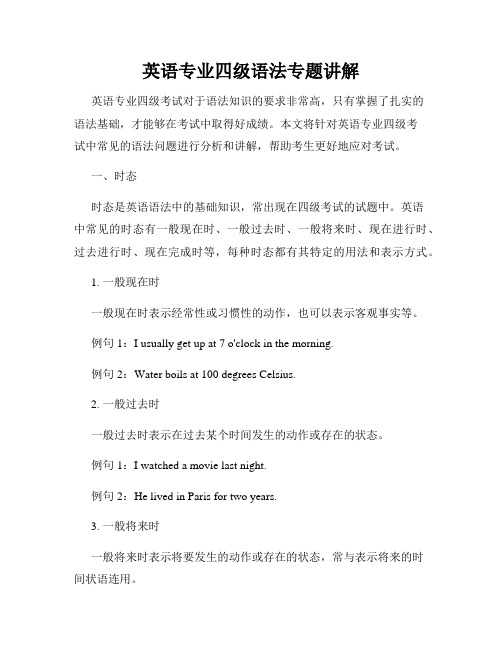
英语专业四级语法专题讲解英语专业四级考试对于语法知识的要求非常高,只有掌握了扎实的语法基础,才能够在考试中取得好成绩。
本文将针对英语专业四级考试中常见的语法问题进行分析和讲解,帮助考生更好地应对考试。
一、时态时态是英语语法中的基础知识,常出现在四级考试的试题中。
英语中常见的时态有一般现在时、一般过去时、一般将来时、现在进行时、过去进行时、现在完成时等,每种时态都有其特定的用法和表示方式。
1. 一般现在时一般现在时表示经常性或习惯性的动作,也可以表示客观事实等。
例句1:I usually get up at 7 o'clock in the morning.例句2:Water boils at 100 degrees Celsius.2. 一般过去时一般过去时表示在过去某个时间发生的动作或存在的状态。
例句1:I watched a movie last night.例句2:He lived in Paris for two years.3. 一般将来时一般将来时表示将要发生的动作或存在的状态,常与表示将来的时间状语连用。
例句1:I will visit my grandparents next weekend.例句2:She is going to travel around the world after graduation.4. 现在进行时现在进行时表示现在正在进行的动作。
例句1:They are studying in the library now.例句2:I am reading a book at the moment.5. 过去进行时过去进行时表示过去某个时间正在进行的动作。
例句1:She was cooking dinner when I arrived home.例句2:I saw him while he was walking in the park.6. 现在完成时现在完成时表示过去发生的动作对现在造成的影响或结果。
专四必备语法解读

专四必备语法一、时态、语态时态、语态需要掌握的要点:1.表达将来时的形式:(1)在时间、条件、让步从句中,一般现在时代替将来时,但要注意区别从句的类型,如:I’ll tell him when you will ring again. 我告诉他你什么时候再来电话。
(宾语从句)比较:I’ll tell him when you ring again.你再打电话时我告诉他。
(状语从句)(2)在make sure, make certain, see (to it) 后的that从句中,谓语动词用一般现在时代替将来时,如:See to it that you include in the paper whatever questions they didn’t know the answer to last time.(include 不能用will include或其他形式) 2.完成时是时态测试的重点,注意与完成时连用的句型和时间状语:(1)by/between/up to/till +过去时间、since、by the time/when +表示过去发生情况的从句,主句用过去完成时。
如:We had just had our breakfast when an old man came to the door.Between 1897 and 1919 at least 29 motion pictures in which artificial beings were portrayed had been produced.(表示1919年时已发生的情况) (2)by +将来时间、by the time/ when +谓语动词是一般现在时的从句,主句用将来完成时。
如:By the time you arrive in London, we will have stayed in Europe for two weeks.I hope her health will have improved greatly by the time we come back next year.(3)by now、since +过去时间、in/during/for/over/the past/last few(或具体数字)years/days/months,主句用现在完成时,如:The changes that had taken place in air travel during the last sixty years would have seemed completely impossible to even the most brilliant scientists at the turn of the 19th century.但在it is +具体时间since/before这一句型中,主句更多的时候不用完成时。
2023年专四英语语法句子成分分析

句子分析新增题型有句子成分、句意理解及语法功能。
一、句子成分如:which of the italicized parts functions as an object?a.he doesn’t like the idea of my speaking at the meeting.b.it is no use your pretending not to know the matter.c.my parents strongly object to my going out alone at night.d.her falling into the river was the climax of the whole trip.[答案] c[译文] 下列哪个句子中斜体旳部分作宾语?[解释] a 中斜体部分为介词短语修饰名词;b 中斜体部分为主语从句;c 中斜体部分为宾语,故为本题答案;d 中斜体部分为主语。
二、句意理解认真对比题干选项,辨别出语义相似和不一样旳选项。
如:“the man preparing the documents is the firm’s lawyer” has all the following possible meanings except ?a.the man who has prepared the documents…b.the man who has been preparing the documents…c.the man who is preparing the documents…d.the man who will prepare the documents…[答案] d[译文] 下列哪个选项旳意思与“the man preparing the documen t is the firm’s lawyer”不一致?[解释] 本题考察目前分词构造与定语从句旳替代。
- 1、下载文档前请自行甄别文档内容的完整性,平台不提供额外的编辑、内容补充、找答案等附加服务。
- 2、"仅部分预览"的文档,不可在线预览部分如存在完整性等问题,可反馈申请退款(可完整预览的文档不适用该条件!)。
- 3、如文档侵犯您的权益,请联系客服反馈,我们会尽快为您处理(人工客服工作时间:9:00-18:30)。
语法考点之一:虚拟语气考点1. If从句中的虚拟语气1、与过去事实相反:从句sb had done,主句sb would(should, could, might)+ have done;2、省略if,从句的语序用到装,即将were, had或should移至主语的前面,但否定词not不前移。
3、与将来事实相反:从句sb did (should+do或were+to do),主句sb would (should, could, might)+do。
4、错综条件句:主句与从句的动作发生在不同的时间段。
比如:从句对过去虚拟,而主句对现在虚拟,即从句sb had done,主句sb would(should, could, might)+do;考点2:表示建议、要求、命令等动词如insist, order, command, suggest, advise, propose, ask, require, request, demand引导的从句及it引导的相应的分词、名词和形容词从句,谓语用(should)+动词原形。
考点3:It is +advisable, essential, important, imperative, incredible等从句,谓语用(should)+动词原形。
考点4:it is (high/about) time that的结构中,从句使用一般过去式。
例如:考点5:much as"尽管,虽然"引导让步状语从句,从句中用would have done表示假设。
考点6:if only, wish, as if/as though引导从句,与过去事实相反:had + done;与现在事实相反:动词过去式;与将来事实相反:could/would + do考点7:would rather/sooner从句中使用一般过去式或过去完成式分别表示对现在或过去的虚拟考点8:lest / for fear that+(should ) +原形动词。
语法考点之二:情态动词*情态动词: will(愿意), shall(将), must(必须), can, may, would, should (应该), might, could, ought to, used to(过去常常), need(需要), dare(竟敢),have to(不得不)考试中,情态动词部分重点测试以下内容:(1)情态动词+行为动词完成式(表示推测)(2)某些情态动词的特殊用法考点1. 情态动词+have+过去分词结构表示推测(1) must have done表示推测过去某事“一定”发生了。
否定形式为:can’t / couldn’t have v-ed, 表示过去不可能发生某事。
(2) could have done表示推测过去某动作“很可能”发生了。
(3) may / might have done 表示推测过去某事“也许”发生了.(4) ought to / should have done 和ought not to / shouldn’t have done用于对已发生的情况表示“责备”、“不满”,分别表示“本应该…”和“本不应该…”(5) needn’t have done 表示过去做了某事,但没有做的必要,意为“本没必要…”。
*did not need to do 动作并没发生。
考点2. 特殊用法(1) should 表示惊讶1. I am surprised__ this city is a dull place to live in.2006A. that you should thinkB. by what you are thinkingC. that you would thinkD. with what you were thinking(2) Can’t but + V.,表示不得不,与have to同义。
Can’t help +Ving忍不住。
(3) cannot … too / enough 表示“无论怎么……也不算过分”、“越……越好”(4) may/ might as well + 动词原形”意为“最好,满可以,倒不如”,相当于had better(5) may well + 动词原形”,意为“(完全)能,很可能”(6) may as well as还是…好了语法考点之三:非谓语动词考点1:不定式(1) 考察哪些动词接不定式;(2) 考察哪些短语接不带to的不定式;Had better/had bestWould rather/would rather … than/rather than/would sooner/would sooner…thanCannot but/cannot help but/do nothing but/do nothing besides/do nothing thanWhy引导的疑问句(3)考察动词不定时的时态和语态:进行式to be doing,完成式to have done;一般式被动语态to be done;完成式被动语态to have been done。
另外,不定式短语有将来时的意思;考点2:动名词(1)常接动名词做宾语的词:mind(介意), miss(逃过), mention(提及), prevent, postpone, practice, risk(冒险),resist(抵制), consider(考虑), admit(承认), avoid(避免), appreciate(感激), fancy(幻想), finish(完成),feel like(喜欢), escape(逃脱), ensure(确保) , delay(延迟), deny(否认), resent, detest, imagine(想象), suggest(建议) (2)介词后的ing:prevent/stop/keep sb /sth from doing 阻止…做…spend/waste time /money in doing 在做…方面花钱、浪费时间或金钱;how /what about doing sth 做…怎么样了?Have some difficulty/trouble in doing 在…方面有些困难;There is no sense in doing (做…是没有理由的)Thank / admire /praise/blame /scold/ punish sb for doing sth因做某事而感谢、羡慕、表扬、责备、惩罚某人(3)接动名词做介词to 的宾语:apply oneself to致力于;be accustomed to习惯于;confess to供认;come to谈到;devote oneself to献身于;get down to着手做;give way to 对…让步;lead to导致;look forward to期待;next to几乎;object to反对;pay attention to注意;stick to坚持;stand up to勇敢面对;turn to求助于;be used to习惯于考点3:分词(1)从语态上看,现在分词一般表主动,过去分词一般表被动;(2)从时态上看,现在分词表示进行,过去分词表示过去。
如果分词动作发生在句子谓语动词动作之前,分词用完成时。
(3)现在分词的否定形式是not放在分词之前。
*非谓语动词解题三步曲:一、首先确定主句;二、分析主动被动;三、分析动作先后1. _____ should not become a serious disadvantage in life and work.2010A. To be not tallB. Not being tallC. Being not tallD. Not to be tall2. "The man preparing the documents is the firm's lawyer" has all the following possible meanings EXCEPT . 2009A. the man who has prepared the documents...B. the man who has been preparing the documents...C. the man who is preparing the documents...D. the man who will prepare the documents...3. ______ at in this way, the situation does not seem so desperate.2000A. LookingB. lookedC. Being lookedD. to look4. If not ____ with the respect he feels due to him, Jack gets very ill-A. being treatedB. treated5. ______, he can now only watch it on TV at home. 1998A. Obtaining not a ticket for the matchB. Not obtaining a ticket for the matchC. Not having obtained a ticket for the matchD. Not obtained a ticket for the match6. He wasn’t asked to take on the chairmanship of the society, ______in sufficiently poplar with all members.1996A. having consideredB. was consideredC. was being consideredD. being considered7. He noticed the helicopter hovering over the field. Then to his astonishment, he saw a rope ladder______ out and three men climbing down it. 1995A. throwingB. being thrownC. having thrownD. having been thrown8. This missile is designed so that once _____nothing can be done to retrieve it.1995A. firedB. being firedC. they firedD. having fired考点4:独立主格(句中没有连接词,逗号分开两个句子,存在两个主语。
